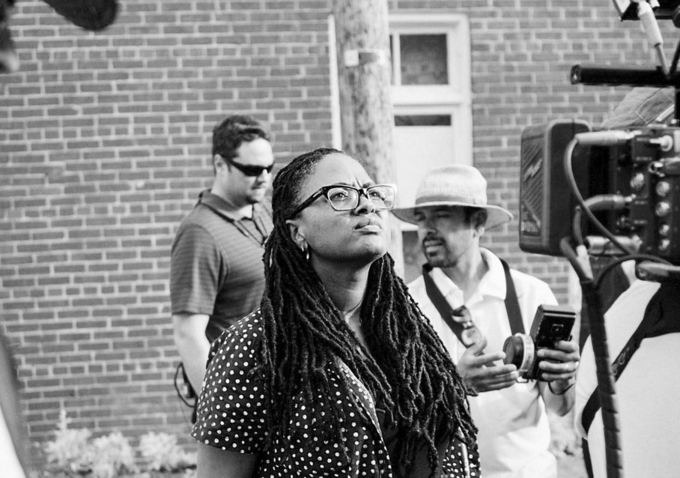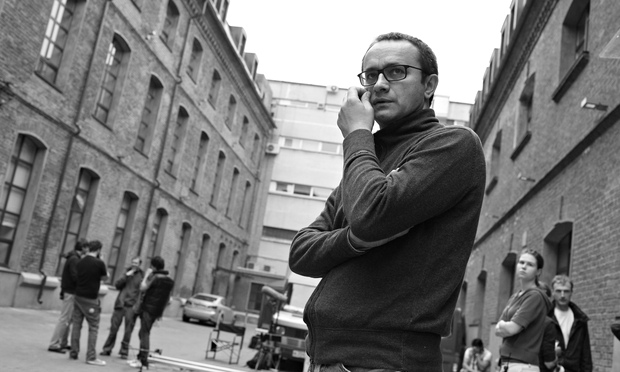Interviews in Russian translated by Oleg Loginov
At first glance, little connection appears to exist between Russian director Andrey Zvyagintsev’s Leviathan and Ava DuVernay’s Selma. Their content differs vastly, with Selma depicting Martin Luther King Jr.’s involvement in the 1965 Selma voting rights movement and Leviathan telling the story of a small-town Russian man whose property is unfairly repossessed by a corrupt mayor. Perhaps unsurprisingly, amidst all the chatter over controversies surrounding each film, not one article mentioned the two in the same sentence, let alone drew parallels between them. Yet article by article, the American media’s reaction to these two films was telling a familiar story — one with roots reaching back to the late 1800s — that pointed up the hypocrisy of our most prominent media outlets.
The months leading up to the Oscars are traditionally filled with controversy, slung hurriedly between cultural critics on a deadline who know all too well the allure of Hollywood-embellished politics. Yet the debate leading up to the Spring 2015 awards took a distinctly hostile turn on December 22 when Mark K. Updegrove, director of the L.B.J. Presidential Library and Museum in Austin, Texas, published an article in Politico Magazine on Selma. This piece declared that DuVernay’s portrayal of Lyndon B. Johnson as an “obstructionist” to voting rights for blacks “[flew] in the face of history.” Why did this alleged misrepresentation matter? Typically artistic license is permissible in historical dramas, Updegrove argued, but “at a time when racial tension is once again high, from Ferguson to Brooklyn, it does no good to bastardize one of the most hallowed chapters in the Civil Rights Movement by suggesting the President himself stood in the way of progress.”
Quickly following Updegrove’s article, The Washington Post published an op-ed on Selma by Joseph A. Califano Jr., former U.S. Secretary of Health, Education, and Welfare and Johnson’s top assistant for domestic affairs from 1965 to 1969. Califano took direct aim at what he described as DuVernay’s false and overdramatized representation of Johnson that ignored “any responsibility to the dead.” Not only was Johnson “enthusiastic” about voting rights, Califano argued, the Selma marches were his idea, not King’s. In fact, Johnson “urged” King to find a place like Selma to protest, one with the worst possible voting conditions for blacks, a strategy Johnson designed to bring national attention to the issue if only King could get the protests on radio and television. Concluding forcefully with what could either be a baseball metaphor or an alarmingly apposite allusion to habitual offender laws, Califano wrote, “That’s three strikes for Selma. The movie should be ruled out this Christmas and during the ensuing awards season.” For the “truth” about Selma, Califano offered a link to a January 15th, 1965 tape-recorded conversation between King and Johnson (also cited by Updegrove), and, importantly, his own “numerous” reports to the White House on the issue, conveniently accessible on the “L.B.J. for Kids!” page of the L.B.J Library website.
Despite what appeared to be fertile ground for contention in Califano’s liberal interpretation of the L.B.J.–M.L.K. tape and unabashed self-citation, not to mention some questions that needed clearing up (What does it mean to “rule out” a film for Christmas?), the New York Times published a front-page article summarizing Califano and Updegrove’s criticisms on December 31. The article, by Jennifer Schuessler, attempted to weigh in on the issue of accuracy in Selma by interviewing prominent civil rights historians on the matter. All four historians interviewed were white, and they all agreed on the film’s inaccurate portrayal. As summed up in one of the introductory quotes from historian Diane McWhorter, “With the portrayal of L.B.J. I kept thinking, ‘Not only is this not true, it’s the opposite of truth.’” Another historian, Julian E. Zelizer, concluded woefully, “The [Selma filmmakers] obviously wanted to create a villain, and really miss who Lyndon Johnson was.” Schuessler didn’t manage to interview any dissenting sources, citing only DuVernay’s own reaction to the accusations against her film as substitute for the counterargument. DuVernay’s December 28 responses on Twitter had been short and direct: “Notion that Selma was L.B.J’s idea is jaw-dropping and offensive to SNCC, SCLC, and black citizens who made it so,” she began. “Bottom line is folks should interrogate history. Don’t take my word for it or LBJ rep’s word for it. Let it come alive for yourself.”
* * *
As debate on Updegrove, Califano, and Schuessler’s articles began to blossom across the internet throughout January, a new controversy was hatching around another Oscar contender, this one for Best Foreign Language Film: Zvyagintsev’s Leviathan. Various U.S. news outlets began reporting that Russian officials wanted to ban Leviathan for revealing, in the words of The Washington Post’s Ann Hornaday, “the grim realities of post-Soviet Russia, where citizens are caught in a system of corruption so thoroughly ingrained that it touches even the most intimate, transcendent moments of life.” Front-running this discussion, the New York Times’ Neil MacFarquhar published a Jan. 27 article delving into what he described as the “national fracas” overtaking Russia in response to Leviathan, in which condemnations of Zvyagintsev were “comparable to the denigration of previous significant artists who had won fame abroad for their unsparing depiction of Russian life, like Aleksandr Solzhenitsyn and Boris Pasternak” (two authors and political dissidents who faced censorship, ostracism, and in the case of Solzhenitsyn, internal exile, due to their critiques of the Soviet state in the 1940s and 50s).
To any reader following the Selma debate, portions of MacFarquhar’s article sounded curiously familiar: A conservative history buff (in this case, Russia’s culture minister, Vladimir Medinsky) attacking a film for its inaccurate and overly negative portrayal of reality; criticism of a director for “vilifying” his own government; a country “polarized” between admiration and resentment of a film, unmasking deeper “culture wars” within the country itself. Unfamiliar, however, were the numerous allusions to censorship, oppression, and totalitarianism. With a vague reference to the opinions of “Russia’s intelligentsia,” MacFarquhar likened Medinsky’s response to Leviathan to the repression of the Soviet era, “when artistic endeavors that did not promote the Communist system as utopia were banned.” Indeed, both the Times’ and The Washington Post’s reviews of Leviathan made it difficult to tell the Soviet era and modern-day Russia apart. As Hornaday wrote, Leviathan’s “unforgettable portrait gives viewers a vivid, melancholy sense of what life in Russia is like for citizens exhausted by political oppression and now bludgeoned by institutional impunity and rot.” Yes, she concludes, “Leviathan is an indictment [. . .] a distinctly Russian tragedy.”
For Zvyagintsev fans, this final line of Hornaday’s review was likely baffling. As far back as October 2014, Zvyagintsev had stated in an interview with Russia Beyond the Headlines (RBTH) that Leviathan’s plot was based on the story of an American man — welder and small business owner Marvin Heemeyer — who got into a fateful zoning dispute with the authorities of Granby, Colorado, in the early 2000s. Heemeyer’s story, the details of which feel painfully American, is arguably more tragic — and more violent — than the “Russian tragedy” portrayed in Leviathan. A resident of Granby for over 10 years, Heemeyer bought two acres of land for $42,000 in 1992 in order to build a muffler repair shop. He considered selling the land for $250,000 in the proceeding years to a family that wanted to build a concrete batch plant, but raised his price so extremely that some believed he was trying to price the buyers out of purchasing his land. Then, in 2001, Heemeyer was hit with a blow. The Granby zoning commission, along with the town trustees, had approved the construction of a cement manufacturing plant in the property adjacent to Heemeyer’s. The design for the plant — which Heemeyer unsuccessfully appealed multiple times — would block access to Heemeyer’s shop. Attempting to compromise, Heemeyer requested to build an alternative road to his shop, but this too was denied. To make matters worse, during the course of the zoning dispute, the Granby government fined Heemeyer a total of $2,500 for various petty violations relating to the condition of his property.
After a failed petition against town officials, Heemeyer stayed quiet for a few years, selling his devalued property to a trash company. But unbeknownst to the town, Heemeyer was slowly transforming a Komatsu D355A bulldozer into what would later be described as the “Killdozer,” a destruction machine outfitted with tool steel and concrete armor, as well as three gun ports with a sniper, a semi-automatic, and a long rifle. On June 4, 2004, Heemeyer used the bulldozer to pummel through thirteen Granby buildings, including the concrete plant, the Town Hall, a newspaper office, and the homes of various individuals involved in the zoning dispute. At the end of the rampage, Heemeyer shot himself. Tapes later released by investigators revealed that Heemeyer believed the rampage was the will of God. “I was always willing to be reasonable until I had to be unreasonable,” he wrote in a note prior to the rampage. “Sometimes reasonable men must do unreasonable things.”
In his interview with RBTH, Zvyagintsev described his reaction when he first heard Heemeyer’s story in 2008: “I was amazed that it should have taken place in the United States. A revolt against injustice perpetrated by the authorities, lawlessness that the man came up against — how could all that be possible in the U.S., which is considered to be governed by the rule of law and where anyone can prove they are right by seeking justice in a court of law? Does it mean that not all is quite so fine there?” This reaction prompted Zvyagintsev to think about how the concept of the “lawless state” was both universal and timeless, dating back to the 5th century when Augustine of Hippo questioned the difference between the state and a gang of thieves in his renowned text, City of God. Reality, Zvyagintsev felt, convinced him that Thomas Hobbes was wrong to idealize the state in Leviathan, his treatise examining the notion of the social contract. “An ideal model can be created on paper,” Zvyagintsev explained, “however the minute a human being, with all their vices and faults, comes on stage, any ideal will easily turn into its opposite. It is no longer a social contract but a contract with the devil. A contract under which a person gives up their freedoms in exchange for bogus social protection.”
Leviathan depicts this ill-fated social contract in the setting of a small Russian town, where a crooked mayor, Vadim, is trying to repossess the home of local mechanic, Kolya, in order to build a community center for church clergy. Mirroring Heemeyer’s story, as well as that of Heinrich von Kleist’s Michael Kohlhaas, Zvyagintsev tells the story of what happens when “a person, not being able to obtain justice by legal means, must do so at the cost of his own life,” as he explained in an interview with Kino Art. For Kolya, the cost is not his own life but the loss of everything he holds dear during his long and futile fight to save his home. By the end of the film, Zvyagintsev explains, “we find our hero in absolute prostration when he has lost everything — house, wife, friend — and life itself is rolling downhill.” Pushed to the edge of despair, Kolya asks a local priest, “Where’s your merciful God almighty?” The priest, offering well-intentioned advice that comes a little too late, responds by telling the story of Job, and asking Kolya to resign himself to his fate in the hope that God’s mercy will come soon. It doesn’t, and instead we watch as Kolya is arrested as a suspect in his wife’s death, his son is left alone without parents, and his beautiful, hand-built house is demolished with all the family’s belongings left inside. The film ends with a sermon by the town’s chief Orthodox priest, who has been the mayor’s confidant in his effort to take Kolya’s home (“You’re doing God’s work,” the priest tells Vadim in an earlier scene). The priest’s sermon is on the importance of speaking the truth, for the truth, he explains, is “God’s legacy” — the key to distinguishing good from evil on earth.
This final scene, rife with hypocrisy and spiritual bankruptcy, prompted many to question Zvyagintsev whether Leviathan was a condemnation of the Russian Orthodox Church. In an interview with RBC, Zvyagintsev responded to these assertions by asking, “Why should [the hierarchs of the Orthodox church] be protected from such criticism? A priest is not sacral. He is as much a servant of God as he is a servant of man. He is as human as I am.” He continued to explain that Leviathan does not indict the church, but rather the practice of bestowing men with god-like power and responsibility, which they will inevitably fail or corrupt. “I want to emphasize that our movie is not anti-Orthodox,” he stated, “and most importantly, it is not anti-Christian. Leviathan at its core is anticlerical, and these concepts need to be distinguished [. . .] Among other things, our movie is about the filth that can come in between people and God, between God and the church. It is about hypocrisy, a holier-than-thou attitude.” Those in power should not be immune from criticism, Zvyagintsev explains, and “the artist, he is always in the position of the critic. It is his duty, the duty of all thinking, intelligent people, to suggest that something’s going wrong [. . .] It’s an inalienable right, the need and obligation of the people who are engaged in art, to scream SOS.”
As the Selma debate has shown, criticizing the human vices of those in power is not always welcomed by the American media. Indeed, perhaps the greatest disturbance for many of Selma’s critics was the fact that DuVernay’s L.B.J. is inconsistent — insecure, even — as he works on voting rights with King, as opposed to the unimpeachable “political mastermind” described by Updegrove and Califano. Yet others besides DuVernay have repeatedly pointed to Johnson’s inconsistent personal and political temperament, documented in numerous historical texts and the multiple biographies on his life. In a New Yorker article titled “Why Selma is More than Fair to L.B.J.,” Amy Davidson examines the historical context surrounding Selma, a time when Johnson was juggling competing legislative priorities and wrestling with political insecurity over his alienation of the Democratic Party’s “century-old” segregationist core, leading him to “[lash] out privately at both King’s negroes and white Southerners.” Contrary to Califano’s assertions, prior to the infamous Jan. 15th conversation, King and civil rights activists had already been planning protests in Selma. What the Jan. 15th tape does evidence, Davidson writes, is the racialized power dynamic between to the two men, in which Johnson would repeatedly interrupt, talk over, or talk past King, a rapport DuVernay captures in Selma. In a worthy read, Davidson points out other factual inaccuracies in the accusations against Selma, and, perhaps most important, questions why a portrayal of Johnson as a human being — who struggled with a monumental decision and ultimately did the right thing — would come across as negative to so many Americans. “The portrayal is multifaceted and respectful, and fully cognizant of [Johnson’s] essential commitment to Civil Rights. What Selma is not, though, is cartoonish or deferential. Is that, again, the problem?” she asks.
Far from an exaltation of Johnson, Selma is a film with many heroes that challenges the hero-worship typical of American textbooks, showing instead the collective, community movements that are needed to make change occur. “It’s important to deconstruct our heroes, whether it be King or L.B.J.,” DuVernay said in an interview with PBS, explaining how she felt “adamant” about illustrating the grassroots organizing behind Selma. “That’s the beauty of King to me,” she explained, “he was a leader of people, so you have to show the people to understand the greatness of his leadership.” The characters on whom DuVernay focuses are the local civil rights activists, such as the Student Nonviolent Coordinating Committee (led by John Lewis, James Foreman, and Diane Nash), the SCLC, the citizens of Selma including many black women organizers largely ignored by history, and the black and white volunteers from across the nation who joined Selma protesters for Bloody Sunday. Watching the brutal, unforgiving violence in Selma, it becomes clear why it would be both absurd and insulting to make the film’s hero L.B.J., or even King, regardless of who conceived of Selma first. For in many ways, Selma is centered around a theme similar to that of Leviathan: if people cannot get justice through legal means, they must obtain it in some other way, often with their lives. And in Selma, it is the community members and activists who risked and in many cases sacrificed their lives in order to get justice when the legal system of the United States of America could not provide it for them.
* * *
Whether or not he was aware, Zvyagintsev’s inquiry into the fairness of the justice system in the United States follows in a long-established tradition of Russian artists and intellectuals, all critics of their own government as well. This questioning of the U.S., or attempt to keep us honest, has always related to human rights, predominantly in the context of America’s treatment of its black population.
One of the earliest examples of such a connection is Leo Tolstoy’s highly influential 1893 non-fiction work, The Kingdom of God is Within You, which explores Christ’s commandment of “non-resistance to evil’ in relation to man’s daily practice of Christianity. The Kingdom of God examines the inability of the state — which, for its own self-preservation, perpetrates war, condones slavery and oppression, and rapes and kills the people of its enemies — to adhere to Christ’s commandment, “resist not evil: but whosoever shall smite thee on thy right cheek, turn to him the other also.” Looking critically at both the United States and Russia, Tolstoy examines the hypocrisy inherent in calling oneself a follower of Christ while adhering to state laws or participating in service for the state. In the opening of the book, he quotes the speeches of two bold American abolitionists and pacifists, William Lloyd Garrison and Adin Ballou, both of whom were keenly aware of the bitter conflict between Christianity, democracy, and slavery in the U.S. and who advocated for doctrines of nonviolence. Ballou specifically discusses the contradiction between Christ’s teachings and the U.S. Constitution, which “requires me to do unto twenty-seven hundred slaves the very contrary of what I would have them do unto me” he wrote in an 1845 article that he sent to Tolstoy.
Ten years later, President Abraham Lincoln would comment on the same dynamic in the years leading up to the Civil War. “As a nation, we began by declaring that ‘all men are created equal,’” he wrote in an 1855 letter to Joshua Speed. “We now practically read it ‘all men are created equal, except negroes.’ When the Know-Nothings get control, it will read ‘all men are created equal, except negroes, and foreigners, and Catholics.’ When it comes to this I should prefer emigrating to some country where they make no pretense of loving liberty — to Russia, for instance, where despotism can be taken pure, and without the base alloy of hypocrisy.” Yet according to Tolstoy, the “contradictions of consciousness” in Russia were no different than those in the United States. Like Zvyagintsev in Leviathan, Tolstoy delineated the way in which power inevitably corrupted those who held it, then seeped into the legislative fabric of society. “We all know that laws are the results of greed, deception, the struggle of parties — that in them there is and can be no true justice,” he wrote. To uphold Christian principles, he wrote, one must abandon service of the state — whether it be military service or participation in local government — and adhere to a doctrine of nonviolence, or the use of passive, nonviolent acts to resist evil and inequity in all their manifestations. Tolstoy’s writings in The Kingdom of God, and his reflections on using love as a political weapon in “A Letter to a Hindu,” went on to inspire Mahatma Gandhi’s philosophies of nonviolent civil disobedience, and, in turn, the nonviolent activism of Martin Luther King Jr.
Half a century after Tolstoy’s writings, in the years leading up to the Cold War, the “hypocrisy” of the United States became a prominent theme in the Soviet Union’s campaign against America. As explained by Mary Dudziak in her book Cold War Civil Rights, at the time, “American racism was seen as the nation’s Achilles heel,” an easy target for the Soviets whenever the U.S. charged Russia with human rights violations. And not only the Soviets noticed the great American contradiction. As Louis Menand of the New Yorker explains, “the nation that had liberated Europe from racist domination” couldn’t be seen as suppressing another race in the eyes of the international community. No, “the trick was to turn a failure of government into something that looked like a triumph of government. Civil rights had to become a story about how American democracy confronted an injustice and eradicated it,” Menand writes. Tasked with the challenge of weaving this success story throughout the 1950s and 60s, both John F. Kennedy and Johnson saw Martin Luther King, Jr. as an opportunity, “a hero whose vision the democratic system could realize.” Indeed, Menand writes, “the triumphalist narrative demanded it.”
Today, the American narrative of equality and democracy is again threatened, and not because of anti-American campaigns waged by foreign enemies or the plots of “inaccurate” films. In the summer of 2013, the 1965 Voting Rights Act won so fiercely in Selma was crippled in the Supreme Court’s Shelby v. Holder ruling, which eliminated Section 4(b), the critical component of the law that identified certain districts with histories of discriminatory voting practices and required them to get “preclearance” under Section 5 of the law before they could make changes to voting processes. The following summer of 2014 would see the rise of the Black Lives Matter protest movement in response to the choking of Eric Garner and the shooting of Michael Brown by white police officers. The deaths of these two black men in Ferguson, Missouri, and Staten Island, New York, and the ensuing failure of U.S. courts to indict the police officers who killed them, prompted a national debate about the ability of black Americans to find justice in U.S. courts or to be protected and supported by law enforcement.
Just as in the 1960s, the Black Lives Matter protests sparked conversations about the international implications of America’s questionable civil rights. In a New Republic article titled “Ferguson Will Make It Harder for Americans to Set a Good Example Abroad,” Julia Ioffe described her experience watching the riots in Ferguson from Moscow where she works as a journalist. She was dining with friends with whom she’d covered the 2010 race riots in Moscow and the pro-democracy demonstrations of 2011–2012. Ioffe remembers rationalizing these Russian protests as “the violence of an authoritarian state dealing with disagreement.” She recalls vividly how, during these riots, “our Russian friends turned to us, the Americans, for answers. ‘This would never happen in America, would it?’ they asked. ‘No, of course not, we told them.’” Now, watching the Ferguson riots, she explains, “it’s hard not to wince looking back at that, our foolish idea of our country,” a time when she believed only “Russian police arrested journalists at protests, not American cops.” Not only do American cops arrest journalists these days, she concludes, they use rubber bullets on protesters, something she never witnessed during the Moscow riots.
Such parallels in the behavior of Russian and U.S. police is the subject of the newest and first English-language song from Pussy Riot, a Russian feminist punk band and activist group based in Moscow. The song, titled “I Can’t Breathe,” juxtaposes the final words of Eric Garner with images of Pussy Riot singers Maria Alyokhina and Nadezhda Tolokonnikova being buried alive while wearing Russian riot police uniforms. “This song is for Eric and for all those from Russia to America and around the globe who suffer from state terror — killed, choked, perished because of war and state-sponsored violence of all kinds,” Pussy Riot wrote on their YouTube page. Interestingly, the U.S. media response to Pussy Riot’s song was not entirely positive. In a Vox article, Kelsey McKinney questioned whether Pussy Riot was appropriating black culture for a “publicity stunt,” and, in an Atlantic article titled “Is Pussy Riot Helping the Eric Garner Cause or Hijacking It?,” Spencer Kornhaber applied a historical lens to question Pussy Riot’s motives. Describing an interview in which Alyokhina and Tolokonnikova allegedly “skip over most everything that makes this American cause American, and speak instead about a universal struggle against state-sanctioned violence, and about Russia,” he points to how Soviets “used” civil rights as “anti-U.S. propaganda” during the Cold War. Could Pussy Riot be using Black Lives Matter in the same way? Kornhaber then muses that perhaps the Pussy Riot song is “a reminder that American protest movements never can, entirely, belong to America.” As to why that might be the case, Kornhaber doesn’t offer an answer.
* * *
Though Selma focused on events of the past, the Black Lives Matter protests were present in the imagery of the film, as white men pushed black men’s heads into concrete, and in the score, with the lyrics of John Legend’s “Glory” directly linking the protests of the Civil Rights Movement to protests in Ferguson. In promoting the film, Selma’s cast and DuVernay did not shy away from contemporary politics, wearing “I Can’t Breathe” T-shirts to the premier of the film in support of protests for Eric Garner. This stance of solidarity triggered more criticism of the film, with one anonymous Academy member commenting to the Hollywood Reporter that she found the T-shirts “offensive,” stating, “Did they want to be known for making the best movie of the year or for stirring up shit?” Following this incident, Cara Buckley hypothesized in yet another New York Times article on Selma how “the movie’s campaign tactics might have hurt its [Oscar] chances. [. . .] The filmmakers and cast inserted themselves into present-day events by wearing T-shirts that read “I Can’t Breathe,” she described, and “this perhaps conveyed the sense, distasteful to some, that they were capitalizing on the politicization of the film. They also screened Selma for schoolchildren, using the film as an educational tool, despite taking artistic license with some facts,” she wrote.
The day before Buckley’s article, the Times had published an op-ed by Maureen Dowd specifically discussing these “schoolchildren.” Dowd’s article describes her experience as a white woman watching Selma “in a theater full of black teenagers.” Commenting first on their talking, texting, and fighting, Dowd goes on to express her concern that many of the students “bristled at the power dynamic” between Johnson and King, making it “clear that a generation of young moviegoers would now see civil rights through DuVernay’s lens. And that’s a shame,” Dowd remarked. Attempting to be fair, she continued, “I loved the movie and find the Oscar snub of its dazzling actors repugnant. But the director’s talent makes her distortion of L.B.J. more egregious. Artful falsehood is more dangerous that artless falsehood, because fewer people see though it.”
Dowd’s declaration of “artful falsehood” was one rich with significance for Brittney Cooper, Professor of Women’s & Gender Studies and Africana Studies at Rutgers. In an article for Salon, she picked apart what she described as Dowd’s “clueless white gaze” that devalues, pathologizes, and reduces black individuals to “fascinating objects of study.” It is this gaze, Cooper describes, that creates an “inability to recognize what filmic representations that respect the interior lives of black people actually might look like.” Cooper then turns the notion of artful falsehoods back on the U.S. and its media, writing,
“Perhaps Dowd is hypersensitive about the alleged ‘artful falsehood’ in Selma because racial politics in this country are a frequent and unrelenting exercise in ‘artful falsehoods.’ That electing a black president signaled the end of racism is an artful falsehood. That police really care to protect and serve black and brown communities is an artful falsehood. That racial progress is linear is an artful falsehood. These are the pretty little lies we tell ourselves to make the fictive narrative of America — the land of life, liberty and justice for all — cohere.”
Importantly, Cooper concludes, when it comes to the topic of “accuracy,” it is important to remember that “those in power choose the ‘facts’ that matter.” And at publications such as The New York Times, those in power are majority white. Indeed, as recently as September 2014, Dean Baquet, the first black executive editor of the New York Times spoke about the need to improve diversity in the Times newsroom. One of the main issues he acknowledged: as of Sept. 2014, out of twenty cultural critics at the paper, not one was black. This dynamic is troubling, among other reasons, because of the Times’ status as one of the most accessed sources of news information, ranking second highest in print and digital subscriptions in the United States and second as the most-accessed online news source in the world.
An absence of editorial and journalistic diversity has many consequences, with one of the worst being a lack of insight and sensitivity that leads journalists to stereotype, ignore, or distort those whom they don’t understand. Schuessler, Buckley, and Dowd’s articles on Selma serve as one such example, followed by the reviews of Leviathan that condemn Russia’s “scorn” of Zvyagintsev while championing the film’s “purpose” of indicting Russia’s unrelenting corruption. The opportunity for Russia-bashing taken in almost every Western review of Leviathan is in part what triggered such a negative reaction to the film in Russia, causing some Russians to believe that Leviathan and its press were “part of some anti-Russian campaign, with Zvyagintsev a willing participant.” In response to these misinformed suspicions, film critic Yury Saprykin published an article in The Moscow Times explaining of the Western media:
“Russia, no doubt, exists on the very periphery of their awareness of the global landscape; even minor political gestures apropos of that country would take them far beyond the bounds of their profession. You might as well claim that the accolades earned by Dogville were part of an orchestrated anti-Danish offensive, or that 4 Months, 3 Weeks and 2 Days was released worldwide to besmirch Romania. Leviathan, much like the films I’ve just mentioned, is of value to any national Oscar committee only insofar as it tells an absolutely universal story in a language comprehensible from any vantage point of European Christian civilization.”
* * *
If, as contended by U.S. media, the Russian response to Leviathan “denigrated” Zvyagintsev, what, then, have we done to DuVernay? And if Zvyagintsev can be compared to a Soviet dissident from the 1950s who was imprisoned and exiled for his anti-state ideas like Alexandr Solzhenitsyn, to whom can we compare DuVernay? To Spike Lee, who has never received an Academy Award? Or perhaps, more boldly, to Eldridge Cleaver, Stokely Carmichael, Assata Shakur, or any of the civil rights activists who were publicly denigrated and exiled from the U.S. in the 1960s? An article proposing such a comparison would likely be laughed out of most U.S. newsrooms for egregious exaggeration. Yet when it comes to Russia, anything’s fair game, despite it being just as unlikely that Zvyagintsev will be exiled, or Leviathan banned, as it is that DuVernay will be jailed for hurting L.B.J.’s reputation.
But there is something to be said for artistic exile, or exclusion, especially in DuVernay’s case. Winning Oscars for Best Director or Best Picture can lead to valuable professional opportunities for a director, and many feel that the accusations of “inaccuracy” in Selma hurt DuVernay’s chances of winning these awards, a notion that is unsettling in light of the few female directors (and absence of black female directors) ever nominated in these categories. Perhaps even more troubling is the notion that DuVernay’s personal activism against contemporary racism put her film under attack, and that her portrayal of Johnson was called “irresponsible” — dangerous, even — in light of the current racial climate in America. Does Selma unpleasantly remind us, as historian Peniel Joseph pointed out, “of the way in which anti-black state violence can impact society even with a sympathetic president in the White House”? And are we afraid of confronting that reality? As Zvyagintsev observed of Russia’s culture minister who so vehemently criticized Leviathan, “He honestly believes that if you clean the movies about life of their wretchedness, then real life will become better too.” Do many of the ‘cultural critics’ published in our most prominent news outlets believe this same narrative? Could it be that we too want a portrayal of utopia in order to avoid civil strife, just like the eternally criticized Soviet regime?
If writing on the controversies of today is so biased, one can only wonder about the historical texts and articles from the 1950s and 60s, and all the unrecorded, unheard conversations lost to a time when there were even fewer journalists of color at major papers than there are now. In light of the uniformity of voices that have told our country’s history, the goal of accuracy is dubious, if not futile. Indeed, as Cooper eloquently writes for Salon, “being more accurate does not mean one has told more truth. Read any Toni Morrison novel, and you’ll learn that novels often tell far more truth than autobiography. DuVernay tells us many truths in [Selma] about the affective and emotive dimensions of black politics, about the intimacy of black struggle, about the spirit of people intimately acquainted with daily assaults on their humanity. The recent tragic killings of unarmed youth have surely taught us that if we don’t work from a presumption of black humanity, facts don’t mean very much in our interpretation of events.”
In a journalistic landscape where major publications rarely capture such black humanity, or the humanity of any non-dominant group, it’s difficult to tell a truth from a lie, a caricature from a portrait, or an opinion from a calculated and hypocritical distortion. Yet the value of hypocrisy has always been, at the very least, to illuminate the flaws of the hypocrite, who so reliably finds his own fault in others. When fingers are pointed at Russia, we would do well to look carefully at ourselves, for as Hobbes famously quoted in Leviathan, “Hell is truth seen too late.”
This post may contain affiliate links.









